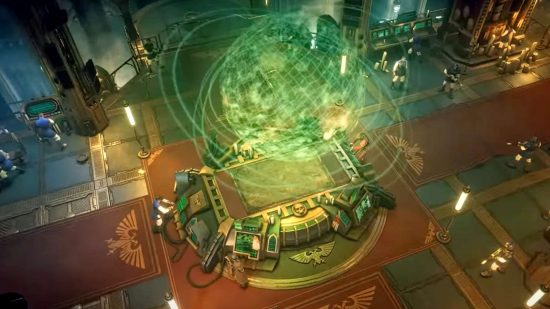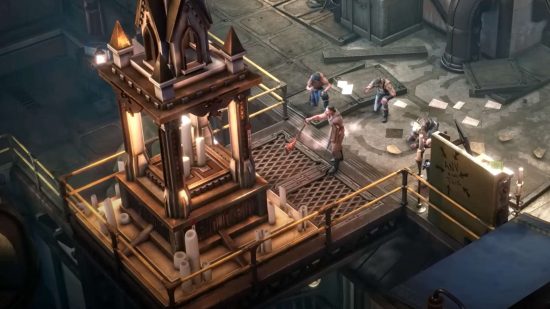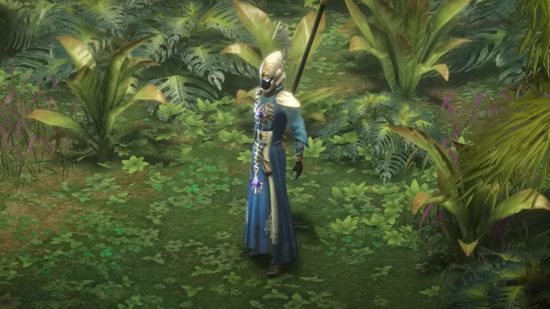Owlcat Games’ narrative lead Olga Kellner and executive producer Anatoly Shestov explained to Wargamer how the team at Owlcat Games aims to bring the many and complex Warhammer 40k factions to life, in its upcoming Warhammer 40k CRPG Rogue Trader. The Owlcat team has delved deep into Warhammer 40k lore to ensure the Koronus expanse feels like a living, breathing part of the 40k universe.
Fans of the tabletop game know that there are about two dozen playable Warhammer 40k factions; but fans of Warhammer 40k books know that the setting is a matryoshka of factions within factions within factions. The Imperium of Man contains a million worlds, and each branch of society – from the Adeptus Mechanicus tech priests to the Imperial church of the Ecclesiarchy – is split into sub-factions, philosophies, and cults.

In Rogue Trader, your character will interact with these local branches of Imperial society, and not the institution as a whole. You’re not dealing with the Adeptus Mechanicus: in Act One you’ll encounter an isolated temple of Electro-Priests who channel the ‘motive force’ through their cybernetic tattoos. From Act Two, you’ll broker trade routes with a fleet of Mechanicum Explorators who are searching for lost technology in the Calixis sector.
That specificity makes the institution easier to understand: you’re dealing with local agents with local ambitions. Paradoxically, this helps to make the setting feel bigger, rather than smaller. The “local” Explorators still have the resources to help you settle new planetary colonies, and they are only one fleet controlled by one sub-cult within the Mechanicus.
Kellner explains that the institutions in the game have been drawn from a variety of sources. Some, like the Electro-Priests, are part of core Warhammer 40k lore – you’ll find them in the 40k Codex rulebook for the Adeptus Mechanicus.
Others come from lore established for the Calixis sector in the OOP Warhammer 40k tabletop RPG Dark Heresy; fans might recognise the Adherents of St Drusus as the local branch of the Imperial Church, or the criminal Kasballica Mission cartel. Others were invented specifically for the game, getting a stamp of approval from Games Workshop.

Shestov explains that the game’s factions come in two flavors: trade factions, and story factions. The Drusians, Explorators, Kasballica Mission, Fellowship of the Void, and Imperial Navy of Battlefleet Calixis are trade factions, who can offer your fabulously wealthy Rogue Trader things worth spending their money on. They’re also the only means through which you can acquire the priceless components needed to upgrade your voidship.
You can curry favor with these institutions by delivering them gifts aligned with their interests; relics for the Drusians, archaeotech for the Explorators, and so on, eventually yielding new trade options. Your own burgeoning fiefdom of planetary colonies throws up challenges that require you to call on their aid, advance their interests, or both. Perhaps a Drusian mission would be the best way to resolve that civil unrest you’re having in your newest colony?
These factions won’t be part of your quest and won’t have story missions of their own – though there will be plenty of story factions tangled up in your narrative. Those story factions are diverse. Some will be direct competitors, with two rival Rogue Traders plying the void of the Koronus expanse; others might be tiny, like an organisation of ship scrappers. Even Xenos races will feature multiple sub-factions, each with different objectives.
Though this separation of narrative-driven story factions from mechanics-driven trade factions is somewhat artificial, it does mean that you can pursue the story and the trading mechanics without worrying that your actions in one part of the game might lock you out of content in the other.

Owlcat Games’ earlier Pathfinder CRPGs position your character as a powerful individual with institutional responsibilities: putting the player into the shiny boots of a Rogue Trader feels like a natural extension for this school of design.
Given how many Warhammer 40k games there are, how deep the setting is, and how many fans it has among game designers, it’s a little surprising that Rogue Trader will be the first ever Warhammer 40k CRPG.
If you can afford it, a public beta of the game is available already. Though with the Space Marine 2 release date due some time before Christmas, and Baldur’s Gate 3 crashing into the public consciousness as the best CRPG and best DnD game ever made – see our BG3 review for details on why, if you’ve somehow missed it – you might want to wait for the Rogue Trader release date to be announced before you commit.


